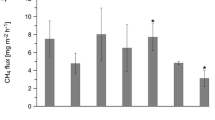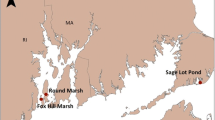Abstract
In mature Phragmites australis and Scirpus lacustris vegetated sediment methane was emitted almost exclusively by plant-mediated transport, whereas in unvegetated, but otherwise identical sediment, methane was emitted almost exclusively by ebullition. Diel variations in methane emission, with highest emission rates at daytime and emission peaks following sunrise, were demonstrated for Phragmites and Scirpus. The diel difference and magnitude of the emission peaks were much smaller for Scirpus than for Phragmites. In contrast to Phragmites, methane concentrations within Scirpus stems did not change significantly over the diel period. These patterns are consistent with a two-way transport mechanism for Phragmites (convective at daytime and diffusive at night-time) and an all day diffusive mechanism for Scirpus. The patterns could not be accounted for by diel variation in air and sediment temperature, plant transpiration, or photosynthetically coupled methane production. Comparison of the experimentally derived ratio of methane emission in helium and nitrogen under light and dark conditions with the theoretical derived ratio (calculated according to the kinetic theory of gases) confirmed the exploitation of the different transport mechanism for Phragmites and Scirpus. Methane emission from Phragmites correlated significantly with incident light, which probably drove the pressure differential associated with thermally induced convection. Decrease of the radial resistance of Scirpus stems for methane transport under light compared to dark conditions, in combination with morphological characteristics of the plant species, suggested that stomatal aperture, regulated by light, controls methane emission from Scirpus. Diel variation in bubble emission from the non-vegetated sediment coincided with sediment temperature changes. The results have important implications for sampling and scaling strategies for estimating methane emission from wetlands.
Similar content being viewed by others
References
Armstrong J & Armstrong W (1990) Light-enhanced convective throughflow increases oxygenation in rhizomes and rhizosphere of Phragmites australis (Cav.) Trin. ex Steud. New Phytol. 114: 121–128
Armstrong J & Armstrong W (1991) A convective through-flow of gases in Phragmites australis (Cav.) Trin. ex Steud. Aquat. Bot. 39: 75–88
Armstrong J, Armstrong W & Beckett PM (1992) Phragmites australis: Venturi-and humidity-induced pressure flows enhance rhizome aeration and rhizosphere oxidation. New Phytol. 120: 197–207
Aselman I & Crutzen PJ (1989) Global distribution of natural freshwater wetlands and rice paddies, their net primary productivity, seasonality and possible methane emissions. J. Atmos. Chem. 8: 307–358
Bendix M, Tornbjerg T & Brix H (1994) Internal gas transport in Typha latifolia L and Typha angustifolia L. 1. Humidity-induced pressurisation and convective throughflow. Aquat. Bot. 49: 75–89
Brix H, Sorrell BK & Orr PT (1992) Internal pressurisation and convective gas flow in some emergent freshwater macrophytes. Limnol. Oceanogr. 37: 1420–1433
Brix H, Sorrell BK & Schierup H (1996) Gas fluxes achieved by in situ convective flow in Phragmites australis. Aquat. Bot. 54: 151–163
Chanton JP & Dacey JWH (1991) Effects of vegetation on methane flux, reservoirs, and carbon isotopic composition. In: Sharkey T, Holland E & Mooney H (Eds) Trace Gas Emissions by Plants (pp 65–92). Academic Press, San Diego
Chanton JP & Whiting GJ (1996) Methane stable isotopic distributions as indicators of gas transport mechanisms in emergent aquatic plants. Aquat. Bot. 54: 227–236
Chanton JP, Whiting GJ, Showres WJ & Crill PM (1992) Methane flux from Peltandra virginica: Stable isotope tracing and chamber effects. Global Biogeochem. Cycles 6: 15–31
Chanton JP, Whiting GJ, Happell JD & Gerard G (1993) Contrasting rates and diurnal patterns of methane emission from emergent macrophytes. Aquat. Bot. 46: 111–128
Chanton JP, Bauer JE, Glaser PA, et al. (1995) Radiocarbon evidence for the substrates supporting methane formation within northern Minnesota peatlands. Geochim. Cosmochim. Ac. 59: 3663–3668
Chanton JP, Whiting GJ, Blair NE, Lindau CW & Bollich PK (1997) Methane emission from rice: Stable isotopes, diurnal variations, and CO2 exchange. Global Biogeochem. Cycles 11: 15–27
Conrad R (1989) Control of methane production in terrestrial ecosystems. In: Andrea MO & Schimmel DS (Eds) Exchange of Trace Gases Between Terrestrial Ecosystems and the Atmosphere (pp 39–58). John Wiley & Sons, New York
Dacey JWH & Klug MJ (1979) Methane emission from lake sediment through water lelies. Science 203: 1253–1255
Denier van der Gon HAC & Breemen van N (1993) Diffusion-controlled transport of methane from soil to atmosphere as mediated by rice plants. Biogeochemistry 21: 177–190
Denier van der Gon HAC & Neue HU (1996) Oxidation of methane in the rhizosphere of rice plants. Biol. Fertil. Soils 22: 359–66
Fechner-Levy EJ & Hemond HF (1996) Trapped methane volume and potential effects on methane ebullition in a northern peatland. Limnol. & Oceanogr. 41(7): 1375–1383
Frenzel P, Rothfuss F & Conrad R (1992) Oxygen profiles and methane turnover in a flooded rice microcosm. Biol. Fertil. Soils 14: 84–89
Frye JP, Mills AL & Odum WE (1994) Methane flux in Peltandra virginica (Araceae) wetlands – Comparison of field data with a mathematical model. American Journal of Botany 81: 407–413
Gerard G & Chanton J (1993) Quantification of methane oxidation in the rhizosphere of emergent aquatic macrophytes – Defining upper limits. Biogeochemistry 23: 79–97
Grosse W, Buchel HB & Tiebel H (1991) Pressurised ventilation in wetland plants. Aquat. Bot. 39: 89–98
Harden HS & Chanton JP (1994) Locus of Methane Release and Mass-Dependent Fractionation from two Wetland Macrophytes. Limnol. Oceanogr. 39: 148–154
Hirschfelder JO, Curtiss CF & Bird RB (1964) Transport phenomena of dilute gases. In: Molecular Theory of Gases and Liquids (pp 514–543). John Wiley & sons, New York
Knapp AK & Yavitt JB (1992) Evaluation of a closed-chamber method for estimating methane emissions from aquatic plants. Tellus 44B: 63–71
Koncalová H, Pokorný J & Kvét, J (1988) Root ventilation in Carex gracilis curt.: Diffusion or mass flow? Aquat. Bot. 30: 149–155
Leffelaar PA (1987) Dynamic simulation of multinary diffusion problems related to soils. Soil Science 143: 43–55
Mevi-Schutz J & Grosse W (1988) A two-way gas transport system in Nelumbo nucifera. Plant Cell and Environment 11: 27–35
Mikkela C, Sundh I, Svensson BH & Nilsson M (1995) Diurnal variation in methane emission in relation to the water table, soil temperature, climate and vegetation cover in a Swedish acid mire. Biogeochemistry 28: 93–114
Minoda T & Kimura M (1994) Contribution of photosynthesised carbon to the methane emitted from paddy fields. Geophys. Res. Lett. 21: 2007–2010
Morrissey LA, Zobel DB & Livingston GP (1993) Significance of stomatal control on methane release from Carex-dominated wetlands. Chemosphere 26: 339–355
Nouchi I, Mariko S & Aoki K (1990) Mechanism of methane transport from the rhizosphere to the atmosphere through rice plants. Plant Physiology 94: 59–66
Schütz H, Holzapfel-Pschorn A, Conrad R, Rennenberg H & Seiler W (1989a) A 3-year continuous record on the influence of daytime, season, and fertiliser treatment on methane emission rates from an Italian rice paddy. J. Geophys. Res. 94: 16,405–16,416
Schütz H, Seiler W & Conrad R (1989b) Processes involved in formation and emission of methane in rice paddies. Biogeochemistry 7: 33–53
Schütz H, Schröder P & Rennenberg H (1991) Role of plants in regulating the methane flux to the atmosphere. In: Sharkey T, Holland E & Mooney H (Eds) Trace Gas Emissions by Plants (pp 29–63). Academic Press, San Diego
Sebacher D, Harriss RC & Bartlett KB (1985) Methane emissions to the atmosphere through aquatic plants. J. Environ. Qual. 14: 40–46
Seiler WA, Holzapfel-Pschorn A, Conrad R & Scharffe D (1984) Methane emission from rice paddies. J. Atmos. Chem. 1: 241–268
Shannon RD, White JR, Lawson JE & Gilmour BS (1996) Methane efflux from emergent vegetation in peatlands. J. Ecol. 84: 239–246
Sorrell BK & Boon PI (1994) Convective gas flow in Eleocharis sphacelata R. Br.: methane transport and release from wetlands. Aquat. Bot. 47: 197–212
van der Nat FJWA & Middelburg JJ (1998) Seasonal variation of methane oxidation in the rhizosphere of Phragmites australis and Scirpus lacustris: A mesocosm study Aquatic Botany (submitted)
Whiting GJ & Chanton JP (1993) Primary production control of methane emission from wetlands. Nature 364: 794–795
Whiting GJ & Chanton JP (1996) Control of the diurnal pattern of methane emission from emergent aquatic macrophytes by gas transport mechanism. Aquat. Bot. 54: 237–253
Author information
Authors and Affiliations
Rights and permissions
About this article
Cite this article
Van Der Nat, FF.W., Middelburg*, J.J., Van Meteren, D. et al. Diel methane emission patterns from Scirpus lacustris and Phragmites australis. Biogeochemistry 41, 1–22 (1998). https://doi.org/10.1023/A:1005933100905
Issue Date:
DOI: https://doi.org/10.1023/A:1005933100905




